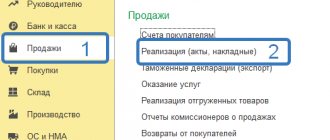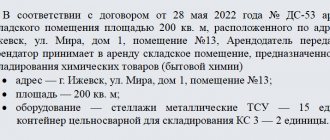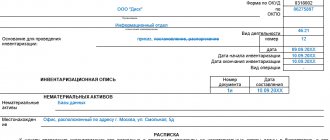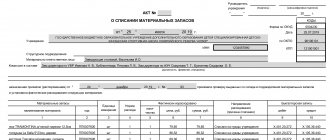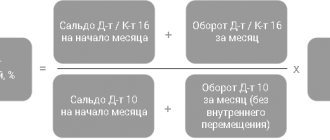When an order and act on the transfer of valuables are drawn up
Legislatively, the need to transfer entrusted property upon dismissal is fixed only for financially responsible persons. To do this, when terminating an employment contract with them, an inventory must be carried out (Part 3, Article 11 of Federal Law No. 402-FZ dated 06.12.2011, Clause 27 of Order of the Ministry of Finance of Russia dated 07.29.1998 No. 34n). Based on its results, an inventory list is drawn up, and if deviations are identified, a comparison sheet is drawn up.
Thus, based on the results of the inventory, the values held by him are written off from the resigning financially responsible person, and responsibility for them is assigned to the new employee or manager.
Mention of the need to carry out a separate procedure for the transfer of valuables is contained in clause 258 of the Methodological Instructions, approved by Order of the Ministry of Finance of Russia dated December 28, 2001 No. 119n - only for warehouse managers and storekeepers .
For persons to whom financial liability cannot be assigned by law, such a requirement does not apply . But in order to ensure control over the property transferred to all other employees, the company can establish in local regulations a mandatory procedure for the transfer of material assets upon the dismissal of any employee.
The procedure may include:
- Issuance of an order for the transfer of material assets upon dismissal of an employee.
- Carrying out direct transfer of property, inventory, fixed assets and materials with their recalculation.
- Registration of the acceptance of the entire list of values in an act signed by the transferring and receiving employees.
The act of receiving and transferring valuables: what is it?
The act of transfer and acceptance of inventory items (TMT) is a special document that allows a company or individuals to control and record their movement.
What does the term “values movement” mean? This is the very moment of transfer of any object of value from one person to another.
Example. Let's consider a situation familiar to many. Two out-of-town students rent an apartment. In this case, the owner of the apartment is the person who transfers the value (apartment) to the students, who accepts responsibility for its safety and the safety of all things inside it. The process of renting an apartment itself is a “movement of material value” from its owner to student tenants.
The transfer and acceptance certificate always indicates in detail all transferred goods and materials with a clear indication of quantity and cost (for example, the same furniture from the example above). This is done to protect them and provide a refund if damaged or lost.
However, the document does not define liability for violating its terms. He only records the fact itself. Therefore, it is best to immediately draw up an addition to it with prescribed sanctions. In the case of the example with students, this is a fine or the purchase of a new thing.
The situation is more complicated when taking into account inventory items at enterprises. Since these organizations have high responsibility, they are forced to closely monitor all movements of inventory items within themselves. For them, drawing up acts is the ideal solution. Thanks to them, the enterprise creates a clear system by which it is possible to track the movement of any inventory items at a certain moment.
For even greater convenience, all things of the organization that have any material value are divided into categories. Each of them has its own article number, which is also indicated in the contract. The categories include:
- Packaging and storage containers;
- Fuel;
- Raw materials;
- The products themselves;
- Construction materials;
- Household equipment, etc.
Example. Office products (printing paper, pens, folders, staplers, hole punches, etc.) are inventory items in the office. In a company engaged in the construction of houses from solid timber, goods and materials are construction materials (logs, materials for foundations, corrugated sheets, metal tiles, etc.)
Contents and procedure for issuing the order
has not been approved by regulations . Therefore, an organization can draw up an order for the transfer of material assets upon dismissal in free form. It must indicate:
- FULL NAME. and the position of the outgoing employee handing over valuables;
- FULL NAME. and the position of an employee who receives valuables under his own responsibility;
- composition of the commission present during the transfer of property and materials;
- the basis for the transfer is dismissal;
- the date on which the procedure must be completed.
ORDER ON ACCEPTANCE AND TRANSFER OF COMMODITY VALUABLES: SAMPLE
If the list of property is extensive, it is advisable to create a commission that will participate in the transfer and confirm the accuracy of the data in the act.
All persons mentioned in it must be familiarized with the order against signature. It is issued before the date of dismissal of the employee with the expectation that he will have time to complete the transfer of values.
SAMPLE ORDER ON TRANSFER OF MATERIAL VALUABLES
Certificate of acceptance and transfer of goods and materials sample form
The act of acceptance and transfer of goods and materials is the document that is intended to accompany the transfer of material assets from one person to another.
Such acts have their own specific features and can be either standard or simply drawn up in accordance with the basic requirements.
Paper rules
This form is created as a text document. If the agreement under which material assets are transferred does not belong to the notarial category, then this act may well be drawn up in the most ordinary written form. It can be created in any required number of copies.
This document must contain:
- an indication of the material assets in question;
- their description;
- identification data, if any, license plate numbers or factory details, or other information.
Also, along with this document, accompanying papers, certificates or passports, warranty cards can be transferred, and all this must also be indicated on the paper.
How to work with papers
When using this paper, each party usually receives its own copy, original and with all signatures. In a situation when it comes to the interaction of legal entities, the papers are signed by managers, and they require seals.
When transferring material assets of one kind or another, representatives of all interested parties can take part in the process, having with them documents of representation. These are, first of all, powers of attorney, which can be executed in both notarized and simple form.
Powers of attorney can be either presented or attached to the deed and accompanying materials. At the same time, at the time of transfer of property, the power of attorney must remain current and confirm all the necessary powers. Only if all these conditions are met and such papers are available, is it possible to officially carry out this procedure.
Thus, the deed of transfer of tangible property is drawn up quite easily and can be created without the participation of a notary. The use of such a document greatly simplifies such procedures and ensures the safety of valuable property.
You should not neglect the development of such papers and their use, so as not to create problems for yourself in the future. After all, practice shows that a negligent approach often becomes a source of problems.
Below is a standard form and a sample transfer and acceptance certificate for goods and materials, a version of which can be downloaded for free.
The need to transfer material assets for rent or storage arises both in organizations and in everyday life. In order for this action to be confirmed by law, it must be recorded using an act of acceptance of the transfer.
Below we will look in detail at how exactly it needs to be drawn up, in what cases it is necessary and we will see a sample act of acceptance and transfer of material assets.
The procedure for transferring property and recording the results
The transfer of values occurs for each item, with inspection and recalculation.
All this is done in the presence of the receiver, the renter and the commission, which checks the provided list of property with the items presented for acceptance. Based on the results of the transfer, an act of acceptance and transfer of valuables is drawn up in any form. It states:
- FULL NAME. handing over and accepting the values of employees, their positions;
- list of all property, incl. names and quantities;
- if a shortage is identified, a note must be made about this in the act;
- signatures of the donor, the receiver and members of the commission.
FORM OF THE ACT OF ACCEPTANCE AND TRANSFER OF VALUABLES
The act is drawn up in 2 copies : for the employer and the resigning employee.
Features of filling out the MX-1 form
The act in form MX-1 was put into effect by Decree of the State Statistics Committee of the Russian Federation No. 66 of 08/09/1999. The form for the act of acceptance of the transfer of material assets in the MX-1 form is formalized in detail. Its use allows us to avoid ambiguities in the interpretation of the terms of storage and liability by the parties. It is this act that is best used in contractual relations. You can download it from the Internet, for example, on the website OBRAZEC.ORG. We will look at the features of filling out some of the columns of this document.
The general part (preamble) contains the details of the parties, as well as links to the document according to which the transfer of values is made.
The first section of the act itself indicates the storage location, for example, warehouse No. 2 at XXXXXXX and the storage period. Sometimes (if the warehouse is large) a warehouse compartment or rack is indicated.
Next, in ascending order of serial number, the goods are listed with the obligatory indication of their brand and packaging (column 2). In column 3 it is desirable to indicate the OKP code. Column 4 is very important, which indicates the characteristics of the product, including the presence of defects or wear. Filling out columns 5,6,7 does not cause any difficulties. In column 5 indicate the units of measurement (pieces, kilograms, liters, etc.), in column 6 - the code of the unit of measurement according to OKEI (can be left blank), and in column 7 - the quantity. Column 8 includes the estimated value of the goods. This column is filled in on the basis of accounting documents (for used products - taking into account depreciation) or by agreement of the parties. Column 9 is the product of the number in column 7 by the number in column 8.
This is interesting: Renunciation of Kazakhstani citizenship when obtaining Russian citizenship: sample text of the application, how to renounce it in the Russian Federation?
At the end of the list, column 9 “Total” is filled in, which reflects the total cost of all items in this column.
Finally, if necessary, indicate the conditions under which goods and the cost of services should be stored for the entire period or for a week/month.
The act is signed by both parties and certified with seals . From the moment the act is signed, all responsibility for the safety of the goods falls on the custodian.
The form of the act of acceptance and transfer from one financially responsible person to another generally differs little from those given above. Let's take a simplified act as an example:
Director of LLC "Avtoelektrik"
_____________ Shishkin I.V.
Transfer acceptance certificate
Chelyabinsk September 22, 2021
This act was drawn up between Petrov Ivan Ivanovich (born 10/11/1984, living at the address XXXXXXX, passport XXXXXXX, issued XXXXX, 10/12/2000) and Vasiliev Ivan Vasilievich (born 11/11/1987, living at the address XXXXXXX, passport XXXXXXX, issued XXXXX, November 12, 2003).
Petrov I.I. transmits, and Vasiliev I.V. accepts the following material assets under financial responsibility:
- welding machines Kaiser MIG-250 (new), manufacturer. No. 32091 and No. 65470, cost per unit 10,000 rubles. in the amount of 2 pcs. Total cost 20,000 rubles;
- jack Forte TA820014-2T (used in working condition), manufacturer. No. 23145, worth 1400 rubles. in the amount of 1 piece;
- jack Forte TA820014-2T (new), manufacturer No. 23765, worth 2400 rubles. in the amount of 1 piece; Litol 24 oil, costing 35 rubles/kg, in the amount of 50 kg. Total cost 1750 rubles.
Passed by _____________ Petrov I.I.
Accepted by _____________ Vasilyev I.V.
